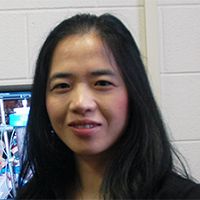Brantley et al., 2013
Using the Susquehanna - Shale Hills CZO to Project from the Geological Past to the Anthropocene Future
Brantley, Susan L., Davis, Kenneth J., Duffy, Christopher J., Eissenstat, David M., Li, Li (2013)
NSF Award # 1331726
-
National, Eel, Luquillo, Shale Hills, INVESTIGATOR, COLLABORATOR
-
Shale Hills, INVESTIGATOR
-
Shale Hills, INVESTIGATOR
-
Shale Hills, INVESTIGATOR
-
Shale Hills, INVESTIGATOR
Abstract
Overview. Humans are changing the Critical Zone (CZ) over large spatial scales at geologically unprecedented rates. Maintaining ecosystem services requires that we project the future of the CZ across space and time. Only with concerted efforts to measure and model the landscape will we learn to make forward projections
or “earthcasts” of both the fast and slow changes occurring in the CZ.
Intellectual Merit. We are working to develop models to use in earthcasting the CZ. Over short timescales and large spatial extents, we are using an atmosphere-land surface model that couples meteorological and ecological processes with hydrological and biogeochemical processes in regolith by parameterizing i) depth to
bedrock; ii) permeability; iii) water uptake by roots; iv) distribution of fractures and macropores. Over long timescales and smaller spatial extents, we are developing models that predict these regolith characteristics as a function of geological and climatological history. Both the land-atmosphere and the regolith models describe changes in water, energy, sediment, and solute (WESS) fluxes, but over vastly different timescales from 10-3 y (water) to 106 y (regolith). For the sedimentary rocks underlying our CZO, we use these models to explore how the geological past has impacted the structure of regolith, and, in turn, how this structure contributes toward controlling today’s hydrobiogeochemical fluxes. The focus of our current work is the monolithologic, forested Shale Hills watershed (~0.1 km2). In the next 5 years, we will upscale to the multilithologic, multiple-landuse Shavers Creek watershed (165 km2). These nested watersheds will comprise the expanded Susquehanna Shale Hills Observatory (SSHO). This upscaling will force us to learn to transition from measuring “everything everywhere” to measuring “only what is needed” and to grapple with the effects of multiple lithologies and land use characteristics. We will use our regolith models as well as publicly available satellite and map data (e.g., soils, land use) to extrapolate from spot measurements of soils and fluxes to the broader watershed. We will test the over-arching hypothesis: To project CZ evolution into the future requires knowledge of geological history, observations of CZ processes today, and scenarios of human activities tomorrow.
Broader impacts. Our biggest impact will be to educate 8 grad students, 1 postdoc, and 8 undergrads in state-of-the-art interdisciplinary research focused on 9 sub-hypotheses facilitated by 11 faculty. At the same time, we will engage scientists from within and outside the CZO community using multiple approaches, including provision of seed grants. An important new focus of Broader Impacts will be to transfer our knowledge from SSHO into the development of hydrological models for two PA watersheds in the region of drilling and hydrofracking for shale gas. For those catchments, we will work with multiple entities to develop models to understand environmental impacts. We will also engage the public by generating the first “CZO Four Seasons” music concert, where Penn State musicians will create a music score from many years of WESS-flux time series data at the CZO. This public concert will be presented at the Penn State Shavers Creek Environmental Center and online.
Citation
Brantley, Susan L., Davis, Kenneth J., Duffy, Christopher J., Eissenstat, David M., Li, Li (2013): Using the Susquehanna - Shale Hills CZO to Project from the Geological Past to the Anthropocene Future. NSF Award # 1331726 .
 This Paper/Book acknowledges NSF CZO grant support.
This Paper/Book acknowledges NSF CZO grant support.
Associated Files
Using the Susquehanna - Shale Hills CZO to Project from the Geological Past to the Anthropocene Future
(2 MB pdf)
EAR - CZO Proposal
Explore Further





